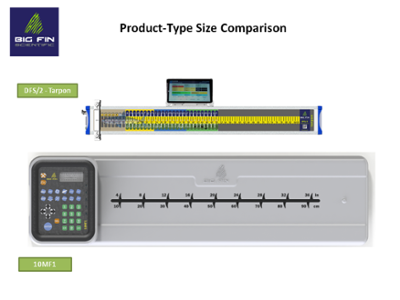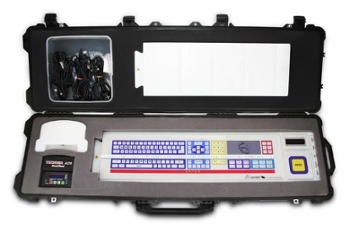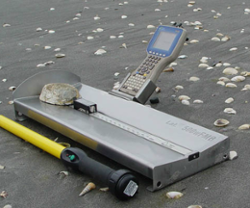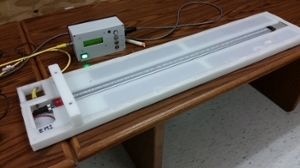What is it? What does it do?
- FEED is a Windows-based, customizable, process-oriented data-acquisition environment designed for (but not limited to) use in fisheries science applications in the field and lab.
- At its core, FEED is an improved front-end for relational/hierarchical MS Access© databases. It replaces Access ‘forms’ and adds many capabilities to the basic Access environment. FEED can also work with enterprise-level database systems such as MS SQL Server, although under the current release certain FEED features may have limited functionality.
- In addition to providing a well-organized interface for entering, acquiring, and editing data, FEED interfaces directly with numerous external data collection devices.
|
History
- FEED was developed by fishery scientists at the Virginia Institute of Marine Science to enable direct data acquisition for multiple fish survey projects both in the field and in the controlled environment of the laboratory or office. To accomplish this FEED had to be customizable for each project’s unique data-collection activities and to have the ability to read data from multiple kinds of external devices.
- Development began in 2012 when VIMS fisheries scientists had to replace the DOS-based hardware/software on which they had depended for more than 20 years. Unable to find any acceptable software solutions, they partnered with Bedko AS of Larvik, Norway to build FEED. Development has continued through several cycles, each time adding more capabilities and interfacing with more devices.
|
Background
- FEED works how you work. Each FEED ‘application’ combines project-specific databases and a set of instructions that tell FEED how to interact with that data base and how to present its data acquisition screen(s) to users. FEED applications can range from the simple and straightforward to very complex. The goal is to match the application to your work process.
- Different data types (Location ID, GPS, Gear Type, Water Quality, Biological, etc.) can be incorporated into a single application or multiple applications. Multiple FEED data acquisition setups can share the same underlying data base.
- FEED guides users through the data entry process, moving focus down the screen step-by-step, field-by-field. Each FEED ‘Level’ connects to a specific data base table. Tables are defined with strict Parent-Child relationships to assure data ‘normality.’ Each FEED ‘Parameter’ is attached to a data field within one of those tables.
- Based on user entries, screens can present varying data recording sequences for different species or for different subsamples of fish within a species.
|
Basic Features
|
How Does it Work?
- Each FEED application is defined by a combination of a customized database and a clear-text file that tells FEED how to interact with the database and how to present its screen(s) to the user(s). A third file which tells FEED how to connect to external devices is also required for some applications.
 |
Which Measuring Boards Will Work With FEED?
Scantrol: FEED was originally developed to receive data specifically from these boards. Scantrol boards use a USB connection to a computer which sees the board as an HID device (Scantrol also offers a wireless Bluetooth model). This makes reading the data into a software package somewhat more complicated than boards which use a serial port though this connection has other advantages such as the ability to power the board directly through the USB connection.  Scantrol boards have internal firmware which can place the ruler line into one of two modes, Length Mode (for measuring) and Function Mode in which the board can send data such as Sex/Species Codes, can change units, etc. Scantrol boards have internal firmware which can place the ruler line into one of two modes, Length Mode (for measuring) and Function Mode in which the board can send data such as Sex/Species Codes, can change units, etc.
FEED supports both of these modes. In Function Mode FEED can use ruler-line positions to trigger macro actions which can, for example, populate a species code field.
Bigfin: BigFin (www.bigfinscientific.com) is a relatively new entry into the measuring board business. VIMS has worked closely with the company both during development of their hardware and in integrating that hardware with the FEED software. BigFin make two basic board designs. These are: the 10MF1 which is a large form-factor board with a ‘headplate’ from which alpha-numeric data can be entered and which contains a 4-line LCD text screen, and the DFS/2 which is considerably smaller (and comes in three different lengths) and contains only a ruler line. The 10MF1 was designed to work in a stand-alone environment and to store data internally. The DFS/2 is meant to work with an Android tablet using software available from BigFin. Both types of boards connect either through Bluetooth or through a USB connection. In both cases the computer sees the board as a serial (COM) port device. FEED integrates well with both of these  boards. BigFin provides a special ‘FEED Mode’ version of the 10MF1 internal firmware and this allows for the ruler line to act in three separate modes: 1) Measure Mode, 2) Alpha-numeric Mode, and 3) Special Mode in which ruler line positions can be defined to trigger FEED macro commands (such as entering species codes). The DFS/2 boards operate differently but offer similar capabilities when used with FEED. In addition, FEED offers the ability to calibrate the DFS/2 board (which needs to be done daily) directly. This means that purchasing a tablet computer isn’t required if the users are not going to use the BigFin software. boards. BigFin provides a special ‘FEED Mode’ version of the 10MF1 internal firmware and this allows for the ruler line to act in three separate modes: 1) Measure Mode, 2) Alpha-numeric Mode, and 3) Special Mode in which ruler line positions can be defined to trigger FEED macro commands (such as entering species codes). The DFS/2 boards operate differently but offer similar capabilities when used with FEED. In addition, FEED offers the ability to calibrate the DFS/2 board (which needs to be done daily) directly. This means that purchasing a tablet computer isn’t required if the users are not going to use the BigFin software.
Bioscribe: These boards were made by Reality Check in New Zealand and marketed in the U.S. by Hallprint (best known for making fish tags). Bioscribe boards connect to a computer via COM port, USB, or Ethernet connections. Custom (mandatory) interface soft ware provided by the company interprets data coming from the board and cause the computer to see the board as a COM port device. The boards feature a full QWERTY keyboard and several special coded areas (e.g. sex codes). Data readings are triggered via a wired stylus. The boards are designed to interface with a set of supplied Excel macros which send data directly into spreadsheets. Except for QWERTY data, readings from these boards contain prefixes which identify the data type to the Excel macros. FEED provides the ability to strip these prefixes so that data can be sent directly into FEED/Access. ware provided by the company interprets data coming from the board and cause the computer to see the board as a COM port device. The boards feature a full QWERTY keyboard and several special coded areas (e.g. sex codes). Data readings are triggered via a wired stylus. The boards are designed to interface with a set of supplied Excel macros which send data directly into spreadsheets. Except for QWERTY data, readings from these boards contain prefixes which identify the data type to the Excel macros. FEED provides the ability to strip these prefixes so that data can be sent directly into FEED/Access.

Lat37: These boards are manufactured by the Lat37 Company, also from New Zealand. The stainless steel construction is considerably different from most other boards but they connect via a wireless COM port so FEED can read their data with ease. No input other than measurements are available.
Ichthysticks: These boards were designed by personnel at NOAA and are not a commercial product. NOAA can supply a complete list of parts and specifications so that scientists can build their own boards (for those not fully electronics-capable construction of control boxes may have to be contracted). The current firmware only allows these boards to be used for measuring, no alpha-numeric or other input is possible. These are serial (COM) port devices and as such FEED can easily receive their data. |
Tradeoffs
The tradeoff for FEED’s customization is a certain amount of complexity. Most likely, you can’t just install FEED, attach your measuring board, and start collecting data. Both the underlying data base and the FEED application file (the ‘.feed file’) must be developed from scratch for each new project (though of course both can be based on and modified from pre-existing applications). At first, especially for those unfamiliar with database concepts, the learning curve for developing FEED applications can be a bit steep. Therefore, application development services are available separately. |
Availability
- FEED is available for licensing through William & Mary.
- Download a fully functional (but session-time-limited) version of the program
- This version contains several actual applications you can try out. Click here for instructions on installing the program and opening these applications.
- At first, especially for those unfamiliar with database concepts, the learning curve for developing FEED applications can be a bit steep. Application development services are offered separately.
|









 ware provided
ware provided 